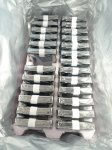rvassar
Guru
- Joined
- May 2, 2018
- Messages
- 972
I got bit by a WD 1TB Black drive a couple years ago. I dropped it in my workstation, installed Linux, and "moved in"... Completely, ssh keys, PGP keys, etc... Powered it off and went to bed. They next morning, I powered it on and it went "ker-thunk... click", and that was that. I then faced the prospect of RMA'ing a < $100 drive I couldn't wipe, that contained encryption & security keys. It's been sitting on the shelf now for 2+ years of it's 5 year warranty.
Lesson learned, I now spin up the drive and run fio against it for at least 24 hours. Something along the lines of:
But I'm curious, how do you burn in new disks? What do you consider a sufficient amount of time?
Rob
Lesson learned, I now spin up the drive and run fio against it for at least 24 hours. Something along the lines of:
Code:
sudo fio --name=randrw --time_based --runtime=86400 --ioengine=libaio --iodepth=64 --rw=randrw --bs=4k --direct=1 --numjobs=4 --filename=/dev/sdX
But I'm curious, how do you burn in new disks? What do you consider a sufficient amount of time?
Rob


